About Me
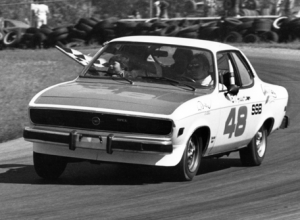 Kids dream of being astronauts or the president when they grow up. Not Eric Foss. He wanted to be a race car driver. From the time he was three years old, he could name the make and model of every car that he saw from the backseat of his grandmother’s car.
Kids dream of being astronauts or the president when they grow up. Not Eric Foss. He wanted to be a race car driver. From the time he was three years old, he could name the make and model of every car that he saw from the backseat of his grandmother’s car.
“Racing is time and money,” Eric explains. “Because he had a family, my dad didn’t have either.”
The dream really isn’t surprising since Eric has had cars racing through his veins since before he was born. His grandfather was an auto engineer for General Motors in Detroit, which meant Eric’s dad and uncle both grew up continually exposed to cars. Eric’s Dad, E.T. , started racing at 19. At 21, he was a club-level racer. That same year, E.T. also became a father to Eric. He put the brakes on his aspirations to be a professional driver to instead be a family man with a graphic arts career.
“Racing is time and money,” Eric explains. “Because he had a family, my dad didn’t have either.”
E.T. continued to race as an amateur, so Eric literally grew up around racing. The cars, the track — it was all part of his youth. Family photos show a 5-year-old Eric waving the checked flag during his dad’s victory lap.
Start Your Engines
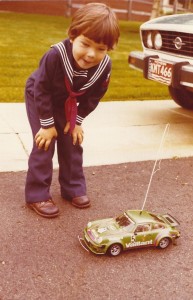 Many of today’s drivers got their start racing go karts, some as young as five. Families then fund their racing progression as the move up into cars. Conversely, Eric’s first driving experience as a youngster was with racing video games at the age of five — an “addiction” that still plays a role in his life today.
Many of today’s drivers got their start racing go karts, some as young as five. Families then fund their racing progression as the move up into cars. Conversely, Eric’s first driving experience as a youngster was with racing video games at the age of five — an “addiction” that still plays a role in his life today.
At 13, Eric’s family moved to Atlanta where his racing passion was fueled by regular visits to Road Atlanta. The elevation change and speed he observed intensified his love for racing. By high school, Eric had started to crew on cars for various race teams. The first time he actually competed inside a car was at an autocross at the age of 16. Others his age already had been competing for a decade.
After high school graduation, Eric moved to Michigan to crew for a professional driver. After the season ended, he returned to Atlanta and continued to crew on the side while also working a full-time job. The proceeds from the job allowed him to attend his first driving school in Michigan at the age of 20. Additional savings allowed him to attend a second driving school when he was 21.
That same year, Eric raced his first car in amateur events. The car was owned by his dad’s friend, William. William offered to pay the racing fees and allowed Eric to race the 1971 Volvo 142, as long as he also maintained the car. Eric liked the taste of competing and he performed well, winning a number of trophies.
Going Pro
Eric’s performance in the Volvo encouraged his friend, Ara, to offer Eric an opportunity to compete in a professional race – that meant prize money was involved. Ara’s Chevrolet Beretta GTZ was eligible to compete in the SpeedVision Cup race series. He offered to let Eric race at Road Atlanta in exchange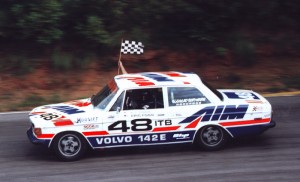 for Eric working on the car to make it race-ready.
for Eric working on the car to make it race-ready.
In 1997, Eric raced his first professional race at the age of 23. It was a three-hour endurance race at Road Atlanta. Eric began the race in 9th position. By the end of his leg of the race, he was in second place.
Eric was lucky during his first few years of racing. But he also was young and hadn’t grown up in the system. Of the contacts he’d made, he didn’t know how to transition them into business relationships. Eric realized the only way he could afford to race would be if someone else paid him to drive. Those offers weren’t coming.
Bitter and 24
Bitter and 24, Eric quit racing.
However, his passion for the sport never wavered. In 1998, he was hired as a racing instructor at the renowned Panoz Racing School at Road Atlanta. In 2002, a student showed up who had a Mazda Miata and wanted to learn to drive the car. After a few lessons, the student asked Eric to drive the car in a 12-hour race. That set the wheels in motion for Eric to start saving money to purchase his own car.
Over the next two years, Eric won a handful of races in the Miata. In February of 2005, Eric and his brother, Ryan, purchased their own street car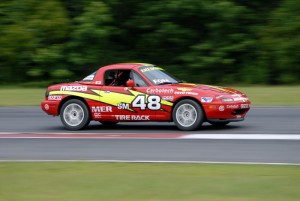 to race in the Spec Miata Class series. They converted it into a race car in the garage of Eric’s Atlanta home, and his first race was in October. He won the race.
to race in the Spec Miata Class series. They converted it into a race car in the garage of Eric’s Atlanta home, and his first race was in October. He won the race.
Eric’s course turned when it was announced the race series was advancing to a national level-class, and the series’ champion would race professionally in the Playboy Mazda MX-5 Cup series with Mazda factory support, which is an entry-level race series for professional drivers.
“We’d built this car for fun, but when the prize was announced, the plan immediately changed from building a car to have fun with, to trying to win the SCCA Spec Miata National Championship,” he said. “This was my second chance at racing. I could take everything I’d learned from driving, and the industry, to try and create an opportunity for myself.”
In 2006, Eric finished the Spec Miata Championship race in fifth place. Over the next two years, competing at the national level was the goal. Eric raced the Miata and his brother crewed. Each also maintained a full-time job. For Eric, that meant he continued to teach others to drive.
Pro and Back
With the help of his students, Eric raced his second professional race in 2007. It was at his home track, Road Atlanta, where he qualified first, led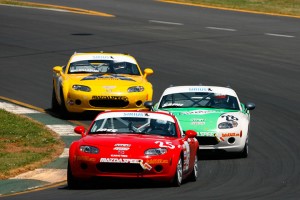 most of the race, and ultimately finished third. His finishing position pushed Eric to work harder to win the SCCA Spec Miata National Championship race that year. Unfortunately, a mechanical failure on the Miata during the final championship race prevented him from finishing.
most of the race, and ultimately finished third. His finishing position pushed Eric to work harder to win the SCCA Spec Miata National Championship race that year. Unfortunately, a mechanical failure on the Miata during the final championship race prevented him from finishing.
Further complicating matters, the racing school that was Eric’s primary source of income closed. The brothers needed money. They no longer could afford to race. They sold the car. Then the trailer. Everything was sold. It wasn’t looking good.
At the beginning of 2008, Eric moved to Fort Worth to become a driving coach for Motorsport Enterprises Racing. He’d been contemplating the move for more than a year. It didn’t hurt that Tila, his future wife, also happened to live in the area. They met when she bought a new car and decided to take advantage of the high-performance driving school the manufacturer was offering at Road Atlanta. Eric was one of the instructors at the time.
Eric’s teaching plans in Texas were quickly challenged when he was asked to compete in all eight races of the 2008 Playboy Mazda MX-5 Cup series. Two different private sponsors offered to pay Eric’s expenses to race for the first half of the season in the Playboy Mazda MX-5 Cup Series.
For the second half of the season, Eric was able to continue the series using his prize winnings. Eric ended up being both the team driving coach and also a driver on the team. The dual duties meant Eric had little time to focus on his own racing career. Race days entailed 14 to 16 hours at the track. After his on-track sessions, he also met with the other team drivers to review their daily performance and offer insight so they could improve. He was living “paycheck-to-paycheck” to make this work.
That same year, Eric also was asked to drive for Saferacer in Spec Miata at the national level. He won.
Eric also won the Playboy Mazda MX-5 Cup series. His success was funded in an untraditional way in racing — sponsors and prize winnings. The result was even more impressive given it was his first full season of professional racing.
For Eric, the 2008 victory was his entry into the Mazda Ladder System. He was afforded an opportunity to race in the 2009 SCCA World Challenge running for the Tripoint Motorsports Factory Mazda Team. Now, Eric got to race for free.
In 2009, Eric drove for Tri Point Motorsports in a Mazda 6 in the Speed World Challenge Touring Car series. He won the Rookie of the Year award and had two pole positions that year.
This was the first year that I raced “Pro” and had full support from Mazda.
Paid Racer
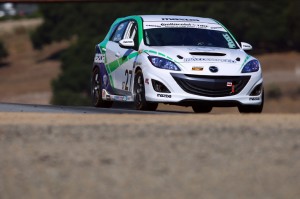 But racing for free on someone else’s dime wasn’t a way for Eric to pay the bills. He decided the only way he could make a living to support his own family, which now officially included Tila, was as a driving coach – not as a driver.
But racing for free on someone else’s dime wasn’t a way for Eric to pay the bills. He decided the only way he could make a living to support his own family, which now officially included Tila, was as a driving coach – not as a driver.
In 2010, Eric took a stand when he decided he wasn’t getting into the car to race unless he was getting paid. He felt he’d performed well enough that his decision was justifiable. Plus, he’d proven to himself that he could be competitive, which is what he’d truly set out to do as a racer. He knew if he wasn’t hired to drive, he’d get hired to coach. Any additional driving time was fun, but paying the bills was the priority.
The first year Eric became a paid race car driver was 2010. His first paid race was for Dallas-based Maxwell Paper Racing in a Porsche. Next, he raced for Freedom Autosport in two races in the Mazdspeed3. Mazda North America paid him to drive with Randy Pobst so they could develop the Mazdaspeed3. This was a new car in the GRAND-AM Continental Tire Sports Car Challenge ST series.
Rolling into 2011, Eric did not have any secured rides. He had, however, lined up a coaching season with Jeff Mosing, whom Eric had previously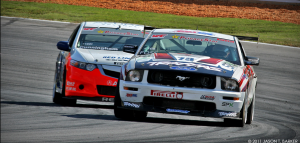 worked with. Shortly after the plan solidified, Eric was contacted about being a paid racer for Traxxas and Freedom Autosport.
worked with. Shortly after the plan solidified, Eric was contacted about being a paid racer for Traxxas and Freedom Autosport.
The first phone call was from Mike Jenkins, the owner of radio-control car manufacturer Traxxas. Mike had purchased a 2008 Ford Mustang FR500S in November 2010.
But this car wasn’t just any car. The car was purchased during the Barrett-Jackson Auto Auction, the proceeds of which went to St. Jude Children’s Research Hospital, which helps fund research that cures and saves children’s lives with pediatric cancer. Mike decided to race the car in the Pirelli World Challenge Races and further solidify Traxxas’ support for St. Jude via the FR500S. Traxxas also formed a partnership with manufacturer Ford, machining company SPX, and synthetic-oil maker Amsoil.
Crew in place, Mike needed a driver. He contacted Eric, whom he knew from his days driving in the SCCA Spec Miata series.
Within days, Eric again was approached by Freedom Autosport to race in the GRAND-AM Continental Tire Sports Car Festival powered by Mazda. Eric co-drove with Brad Rampelberg who won the Playboy Mazda MX-5 cup series the previous year. Mazda wanted to have two of their Mazda Ladder System drivers in the same car.
Only months earlier, Eric was thinking he’d need to take a desk job somewhere in the industry. Two phone calls later, he had two-paid driving gigs.
“At this point in my career, if all the driving opportunities went away, I wouldn’t be bitter at all,” Eric said. “I set out and accomplished most of my objectives. I know that I can continue with my coaching. But any time I get to drive – that’s a bonus!”
